Stone sinks for the kitchen: pros and cons, types and choices

Natural stone sinks are no longer an exotic phenomenon in Russia. Natural rocks and minerals, composite materials, including quartz agglomerate, used for the manufacture of kitchen sinks, have a lot of advantages. Stone sinks for the kitchen have gained popularity among connoisseurs of modern design. Such plumbing fixtures look much more respectable than classic metal options, are stronger than ceramics and go well with the most relevant interior solutions.



Advantages and disadvantages
Kitchen sinks made of artificial and natural stone are now produced by many well-known brands in Russia, Europe, and the USA. Kitchen stone sinks are widely used by homeowners thanks to the obvious advantages that this washbasin option has.
- Excellent durability. The stone surface is not afraid of mechanical damage, shock loads. They easily withstand contact with sharp metal objects. And the fall of heavy dishes will not deform the material.
- Heat resistance. Natural stone can withstand any temperature. Artificial materials have some limitations, but they quite successfully cope with the task of washing dishes and vegetables. It is enough just to follow the manufacturer's recommendations.
- Hygienic safety. Both natural stone and its artificial counterparts make it easy to maintain maximum purity. The coating is not porous, excludes the accumulation of bacterial plaque, the appearance of rust or an unpleasant odor.
- High chemical resistance. Stone sinks do not react with acids and alkalis, preserve the integrity of the coating after contact with other aggressive substances.
- Easy to care for. Stone sinks are easily cleaned of dirt, do not require complex maintenance, and can be restored if necessary.
- Long service life... The product does not need to be replaced even a decade later; it will retain its attractive appearance after many years of use.
- A wide range of models and sizes. You can choose built-in, surface-mounted, hanging versions, give preference to round, oval, square or rectangular sinks. The color scale and even the texture of the material are also much more diverse than that of metal structures.
- Minimum noise level. When in contact with a stream of water, the surface of a stone sink does not emit unnecessary sounds, moreover, the liquid flows smoothly, and does not spray on the sides.



Not without its drawbacks.
- Stone kitchen sinks are quite expensive, they can hardly be called a budget option.
- Such products are much more massive and require a solid foundation. They also need to be transported and installed, taking into account the severity of the chosen shell.
- Even a stone can be chipped and cracked with a strong impact.
Varieties of shells
The variety of stone sinks can be envied by any other plumbing options. Products designed for premium kitchens are developed by designers and harmoniously fit into the design of the most spectacular interiors. On sale presented single and double versions of sinks, versions with a recessed bowl, dish drainer.



There are models with a different installation method, and all these points have to be taken into account when replacing an old sink with a new one made of natural or artificial stone.
Forms
Among the options for the shape of stone kitchen sinks, some are considered the most popular.
- Round. Popular design solution that takes up little space and is well suited for a variety of installation methods. Deep round stone sinks avoid splashing water, suitable even for small kitchens.
- Oval. They look impressive, increase the usable area of the interior of the sink, and look good in island structures.
- Rectangular or square... The most common option, fits well into straight countertops. A single sink is most often rectangular, while a double sink combines 2 small square sinks.
- With a wing. This is the name of a platform with a ribbed surface located to the right or left of the bowl, designed for water to drain. Such sinks are convenient if fruits, vegetables, and individual cutlery are often rinsed in them.
- Corner. A rounded or trapezoidal stone sink is easy to place in an L-shaped or U-shaped kitchen.
- Arbitrary. They are made to order according to individual sizes and parameters. It is possible to create a product with one straight edge and a semi-oval, complex double options, in the form of aligned circles.


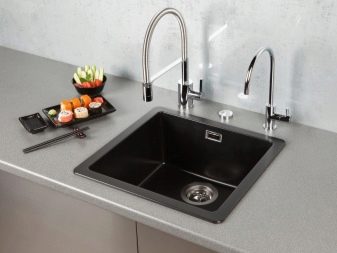

When choosing a shape for a stone kitchen sink, it is important to consider all factors: from the size of the countertop to the location of the sink.
Dimensions (edit)
The standard dimensions of a stone kitchen sink are determined taking into account the peculiarities of the size of the kitchen set. A small sink will be 45-50 cm wide. The standard version is 60 cm. Large sinks will be 80 cm wide. Length parameters are individual: from 50 to 100 cm. It is influenced by the features and characteristics of the product.

The weight of a stone sink depends on the material used. Artificial raw materials usually have weights in the range of 8 to 18 kg. Natural materials are even heavier and require a massive or reinforced base.


For example, a product made of granite or basalt rock with a standard sink width of 60 cm can weigh up to 80 kg.
Installation methods
All used stone sinks for the kitchen are subdivided according to the method of installation.
- Embedded... Most popular today. The sink is built into the worktop, taking up space in the overall design of the headset; shelves and storage system drawers are located next to it. The bowl is positioned below the level of the table top so that a protective rim is formed to prevent overflow of water. As a rule, these shells are the most spacious; they are often equipped with a wing.
- Mortise. They are fixed under the countertop, then the seams are sealed, and the structure is used as intended. Not the most convenient option that requires a lot of work. That is why it is almost never used by professional installers.
- Overhead. A fashionable idea that allows you to choose any shape of the sink, to vary the depth of the bowl. With the rims protruding above the worktop, you don't have to worry about splashing water. But the design features do not allow such a sink to be roomy.



Materials used
Among the materials used in the manufacture of stone sinks, natural stone and its artificial varieties are distinguished. Depending on the version, it is possible to highlight composite and solid versionsproviding opportunities for reliable imitation of natural raw materials. Natural stone can be polished or polished, retain its texture, acquire a mirror-like smoothness.


A natural stone
Among the natural minerals and rocks used to make kitchen sinks, granite and basalt are leading. In terms of their hardness, they are in the upper part of the Mohs scale, have high impact resistance and chemical resistance. Contact with acids, mechanical stress and other external factors do not affect their performance in any way.


Unsurprisingly, granite and basalt kitchen sinks often come with a lifetime warranty from the manufacturer.
Marble and travertine — some of the most beautiful types of natural stone. They are distinguished by the uniqueness of the ornament, heat resistance, resistance to moisture and UV rays. They are ideally suited for constant contact with water, allow realizing almost any design fantasies and solutions due to their good plasticity.
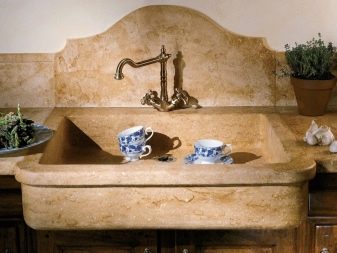
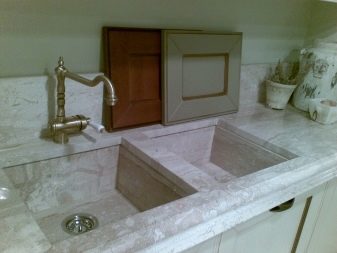
When using marble and travertine sinks in the kitchen, it is very important to remember on a number of limitations inherent to these materials. We'll have to exclude contact with vinegar, lemon juice and other acids: they destroy the structure of the mineral. Due to the porous surface, there is a risk of staining light marble with bright vegetables and fruits, and other products.


Intense impact on the surface with sharp cutting objects can leave scratches on the stone.
Onyx kitchen sinks are an exclusive design solution. They are quite expensive: the stone is classified as semiprecious, and is not mined in large quantities. The translucent structure of the material allows the use of backlighting, creating solutions that are unique in their beauty. Onyx is resistant to moisture, lends itself well to processing, you can create complex figured products from it.

Artificial
Artificial stone sinks are of high quality. Visually, they are almost identical to natural ones, but they are much cheaper. In the composition of the material, composite substances are usually isolated (their share reaches 20%) and stone chips, which act as a base. In some cases, coloring pigments are additionally used to give the structure the desired color.
- Acrylic. In this case, the sink is created in the form of a cast product from various components: acrylic resins, polymerizing substances, mineral inclusions. Acrylic stone sinks are the most affordable, but in performance properties they are much inferior to natural and other artificial counterparts. You cannot put hot dishes in such a sink, and the surface is easily covered with scratches.
- Artificial granite. The most durable version of artificial stone sinks. Granite chips retain their strength even in crushed form, the composite material acquires additional plasticity, allows the creation of products of the desired shape, regardless of their characteristics and complexity. The higher the content of natural stone in the composition of the product, the stronger it will be. To improve performance, quartz can be mixed into the composition.
- Artificial marble. Created on the basis of marble chips by casting. This material also has certain disadvantages. Often unscrupulous manufacturers create such sinks based on polyester resins, making them cheaper and less resistant to external factors. Sinks made of cast marble do not tolerate temperature extremes and mechanical abrasion. Over time, the material fades, the protective layer is erased, the surface becomes porous.
- Porcelain stoneware. This imitation stone is composed mainly of clay and quartz sand. Its resemblance to rock is only superficial. The material is quite durable and practical, is not afraid of chemical and thermal effects, withstands acidic, alkaline effects. But porcelain stoneware is not too resistant to shock loads, the sink can crack, crack.



Color and type of surface
Artificial stone sinks can be made in almost any color and shade. The most popular are gray and graphite, white, black options. Beige sinks are built into the brown and cream countertops. In addition, for designer kitchens, manufacturers offer bright pink, blue, green, red, chocolate color options.



For individual production, the manufacturer can use pigments at the request of the customer.
In a monochromatic version, artificial sinks imitating stone are rare. Most often, their surface is covered with an ornament that recreates the texture of the mineral. Such a pattern looks more interesting, hides small chips and defects; traces of dirt are not so noticeable on such a surface. Popular design options include black specks on a white background, or light ones on dark, gray or anthracite.


The surface texture of the artificial stone used in the manufacture of sinks is more diverse than that of its natural counterparts. It can be a glossy or silky matte finish, imitation of a mineral in antique or shagreen finish, when the sink looks like it has been carved out of a solid block of stone. The more structured the surface is, the more reliable the imitation will be. The color range of natural stone sinks is no less varied. It all depends on the choice of material breed.
- Granite it can be pink, gray, red, black, beige. There are even rare blue, yellow, green varieties. Depending on the deposit, grain size and color intensity change.
- Marble most appreciated in white. A black stone with snow-white veins, a red and pink mineral looks quite beautiful. Beige, yellow, gray and green marble looks noble.
- Onyx has a not so rich color gamut. Most often, the background color is white or beige, greenish, pink, orange-red. Due to its striped layered structure, its tone is never uniform.
- Travertine has a characteristic white color with a yellowish ivory tint. In addition to the white and beige colors of the sinks, you can find yellow, gray and red options.
- Basalt always has only black or graphite gray colors.



The surface texture of natural stone provides for only 2 processing methods: polishing to a mirror-like smoothness and creating a rough structure, like that of natural tuff. These options are available for granite, marble, travertine.
Manufacturers rating
The rating of stone sink manufacturers includes both European and Russian brands.Products made from natural stone are presented on the Russian market mainly in domestic production. Among the leaders are firms such as Plumbing G, Sheerdecor, Paradise, OrganStroy.

Most brands have a selection of ready-made models from the catalog, and the possibility of creating custom-made products is provided.
One of the leaders among foreign companies is a Japanese manufacturer Omoikiri, self-mining stone using a special technology. The rating of manufacturers of sinks made of composite or acrylic includes several brands.
- Blanco... A company from Germany using Silgranit material, which is 80% granite chips. In the catalogs of the company there are sinks with various designs that are not afraid of mechanical, thermal effects, and sunlight.
- Franke. Another German brand that produces sinks from the patented Fragranite material. The catalog contains products in 9 colors, many options for shapes. It contains 20% acrylic and 80% granite.
- Longran... A company that has been supplying the Russian market for over 20 years. Production is carried out in Italy, India, Turkey. Lonstone composite material is used as the basis of the product.
- Teka. A German brand that manufactures products from Tegranit Plus material, which contains 70% or more natural filler - stone chips. The rest of the volume is filled with acrylic binder and coloring pigments. The catalog contains a choice of 8 colors, there are products of different shapes and sizes.
- Granfest. A Russian company that has been producing products of a competitive level for more than 15 years. The brand has its own design bureau, modern production lines.
- "Polygran-M". A company from the Russian Federation that produces stone sinks under the brands Tolero and Polygran. The price of the products compares favorably with the proposals of European competitors.


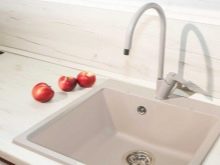
These companies do not exhaust the list of manufacturers of artificial stone sinks. When choosing a brand, it is important to pay attention to the fact how high quality raw materials he uses... There are quite a few fakes on the market that do not meet security requirements.

How to choose?
The choice of a stone kitchen sink largely depends on the interior design of the room. There are many attractive and interesting design options for sinks, their shapes and colors. But there are also criteria that largely determine the service life and other characteristics of the material. It is imperative to pay attention to individual parameters.
- Material type. Natural stone is too heavy to fit on budget wood-based board sets. Artificial options often look no worse, but noticeably lighter than their counterparts. Quartz and granite composites are stronger and more durable than marble and acrylic composites.
- Size and shape. Large, roomy kitchen sinks are highly valued. But you need to take into account the parameters of the countertop. In a standard headset in an apartment, it is better to put a sink no wider than 60 cm, square or angular. In a kitchen with an island, you can use any size sink. Oval and round models are mainly built into designer kitchens.
- Sink construction... For a large family or a hostess who is keen on cooking, a double sink or a model with a drying wing will be useful. In a bachelor apartment, a compact square or round sink without high sides will be appropriate.
- Color and design. Classic white stone sinks look boring. It is much better to decorate the interior with a black, gray, beige sink or choose more original options. It is worth focusing on the general style in the design of the room, the personal preferences of the owners.
- Budget. Prices for sinks made of natural stone start from 20 thousand rubles for one product and can reach 200-500 thousand rubles in a designer version. Artificial counterparts are much cheaper. Russian products cost from 3 to 8 thousand rubles, foreign ones - up to $ 1,500.


Operation and care
To extend the service life of natural stone sinks, they must be periodically covered with special protective impregnations. Such materials increase moisture resistance, prevent the absorption of odors and impurities by porous minerals. In the case of marble and travertine the presence of impregnation will reduce the risk of discoloration of the surface.
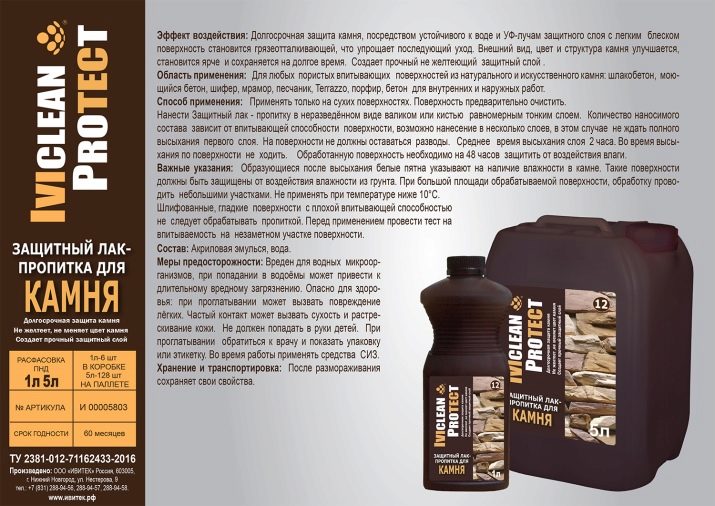
The coverage is renewed regularly, at least once a year. Granite and basalt are processed every 5 years.
Cleaning the surface of natural stone sinks is recommended using mild detergents and cleaning agents... The use of metal sponges and brushes should be excluded. The best choice is to use a soft cloth and a neutral cleaner with a degreasing effect.
Caring for products made of artificial stone also has its own characteristics. Necessary:
- observe the installation rules, carefully seal all joints;
- after each use, clean the walls and bottom of the bowl, if possible remove moisture from them;
- clean weekly with special detergents;
- when placing hot dishes, you need to use coasters;
- protect budget models of sinks from direct contact with boiling water.


Respect for stone sinks allows you to extend the life of these products, even if they are used in the harsh conditions of a modern kitchen. It is worth following all the recommendations and taking care that the surface of the bowl remains clean after use.
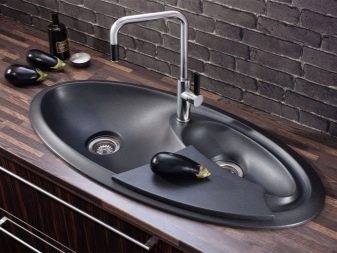

How to choose a stone sink for your kitchen, see below.








